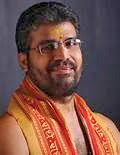Self Sufficient Villages in Today's Global Village :3.
The relevance of Gandhian economics :
By Dr. Moushumi Datta
Nagindas Khandwala College, Mumbai.
3. Discussion
Today the world is divided into two halves, the developed and the underdeveloped, the privileged and the underprivileged, the rich and the poor. In the global village of today two distant worlds exist. However, the global village is still linked in a very complicated manner wherein if USA sneezes, China catches a cold. It means that no country is isolated from another and every country's fate is dependent on the world at large. The world today is struggling to come out of recession which is essentially driven by mismatch of demand and supply. As borders come down the threat from lower priced products entering the developed countries and eating into high product cost and thus eroding the demand base for local industries is very real. This is where Gandhi's thoughts on economic development of India in the 1950's, have become relevant. If the world as a whole is taken as a country, the developed nations of the world as megacities and the developing and the underdeveloped nations as villages, then, it will be easy to put Gandhi's thoughts on economics into perspective.
Gandhi espoused an economic theory of simple living and self- sufficiency. He envisioned a more agrarian India upon independence that would focus on meeting the material needs of its citizen prior to generating wealth and industrialiation. Gandhi realised that the fabric of the Indian economy rests on the rural base. In fact, Indian planners have again and again turned to take a second look at the rural sector from the Gandhian point of view. Gandhi was not against industrialisation but his venue was half a million villages which he wanted to see. developed as authentic village republics. Fundamentally, Gandhi opposed machinery because he thought it displaced labour and it concentrated production and distribution in the hands of a few. He pleaded for technology that would supplement and complement man-power and animal power available in India. That was the way to safeguard unemployment and starvation.
Gandhi focused on rural development for the last thirty years of his life. He felt intuitively that the future of India is in decentralised rural development. He believed in local production and consumption. This was his concept of a dream village.
Gandhi's concept of decentralised economy and industrialisation would perhaps have led to a prosperous village population with an exploitation-free equitable distribution of natural resources, means and instruments of production as well as the produce. The fact that India is now concentrating on the production of bio-gas and solar energy is itself a vindication of Gandhi's ideas. In the political field, we are experimenting with Panchayati Raj and Lok Ayuktas.
Gandhi emphasised employment. The full employment of human resources is the primary need of a country. By full employment, Gandhi meant the employment of each and every individual. Full employment cannot be attained through the development of large scale industries. Most of the unemployed people live in rural areas. The cause of rural underemployment is the seasonal nature of agriculture. The problem of unemployment can be tackled only by developing village and cottage industries. These industries are capital-saving and labour-using. They take employment opportunities to the doors of the unemployed and ideally fit in with the rural conditions.
Next :Thoughts of Gandhi Reinforced into the Current Economic Scenario:
Reverse Migration-
Continues...




Comments